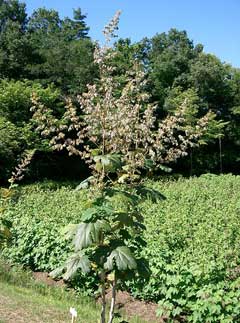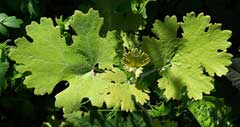 |
|
http://commons.wikimedia.org/wiki/User:KENPEI |
 |
|
Translate this page:
Summary
Bloom Color: White. Main Bloom Time: Early summer. Form: Upright or erect.
Physical Characteristics

 Macleaya cordata is a PERENNIAL growing to 2 m (6ft) by 1 m (3ft 3in) at a fast rate.
Macleaya cordata is a PERENNIAL growing to 2 m (6ft) by 1 m (3ft 3in) at a fast rate.
See above for USDA hardiness. It is hardy to UK zone 3. It is in flower from July to August. The species is hermaphrodite (has both male and female organs).
Suitable for: light (sandy), medium (loamy) and heavy (clay) soils and prefers well-drained soil. Suitable pH: mildly acid, neutral and basic (mildly alkaline) soils. It can grow in semi-shade (light woodland) or no shade. It prefers moist soil.
UK Hardiness Map
US Hardiness Map
Synonyms
Bocconia cordata. B. yedoensis.
Plant Habitats
Cultivated Beds;
Edible Uses
References More on Edible Uses
Medicinal Uses
Plants For A Future can not take any responsibility for any adverse effects from the use of plants. Always seek advice from a professional before using a plant medicinally.
Carminative Depurative Diuretic Stings
The whole plant is analgesic, antioedemic, carminative, depurative and diuretic[218]. The juice from the stems of the leaves is used to treat insect bites[4]. A decoction of the leaves and stems is used in the treatment of ringworm[218]. The poisonous sap is used to counter poisonous sores[218].
References More on Medicinal Uses
The Bookshop: Edible Plant Books
Our Latest books on Perennial Plants For Food Forests and Permaculture Gardens in paperback or digital formats.

Edible Tropical Plants
Food Forest Plants for Hotter Conditions: 250+ Plants For Tropical Food Forests & Permaculture Gardens.
More

Edible Temperate Plants
Plants for Your Food Forest: 500 Plants for Temperate Food Forests & Permaculture Gardens.
More

More Books
PFAF have eight books available in paperback and digital formats. Browse the shop for more information.
Shop Now
Other Uses
Insecticide Musical
The dried hollow stems can be used as whistles[178]. Kills insects and mosquito larvae[147]. The flowers are used to kill maggots whilst the whole plant is used to kill larvae and insects[218].
Special Uses
References More on Other Uses
Cultivation details
Landscape Uses:Border, Massing, Specimen. Requires a well-drained deep soil[1] preferring a sunny sheltered position but tolerating light shade[200]. Easily grown in sun or partial shade[187]. Hardy to about -15°c[187]. A very ornamental plant, it can be grown as an isolated specimen in a lawn[1]. An excellent plant for sub-tropical bedding[1]. Plants have spreading underground rhizomes[187] and can be invasive[200]. Special Features:Attractive foliage, Invasive, Naturalizing.
References Carbon Farming Information and Carbon Sequestration Information
Temperature Converter
Type a value in the Celsius field to convert the value to Fahrenheit:
Fahrenheit:
The PFAF Bookshop
Plants For A Future have a number of books available in paperback and digital form. Book titles include Edible Plants, Edible Perennials, Edible Trees,Edible Shrubs, Woodland Gardening, and Temperate Food Forest Plants. Our new book is Food Forest Plants For Hotter Conditions (Tropical and Sub-Tropical).
Shop Now
Plant Propagation
Seed - we have no information on this species but suggest sowing the seed as soon as it is ripe in a cold frame in the autumn. Stored seed should be sown in the early spring. When they are large enough to handle, prick the seedlings out into individual pots and grow them on in the greenhouse for their first winter. Plant them out into their permanent positions in late spring or early summer, after the last expected frosts. Division in the dormant season[200]. Basal cuttings in late spring. Harvest the shoots with plenty of underground stem when they are about 8 - 10cm above the ground. Pot them up into individual pots and keep them in light shade in a cold frame or greenhouse until they are rooting well. Plant them out in the summer. Cuttings from the axils of larger leaves in early summer[200]. Root cuttings in the winter[188].
Other Names
If available other names are mentioned here
Native Range
TEMPERATE ASIA: China, Japan (Honshu, Kyushu, Shikoku), Taiwan (north)
Weed Potential
Right plant wrong place. We are currently updating this section.
Please note that a plant may be invasive in one area but may not in your area so it's worth checking.
Conservation Status
IUCN Red List of Threatened Plants Status :

Growth: S = slow M = medium F = fast. Soil: L = light (sandy) M = medium H = heavy (clay). pH: A = acid N = neutral B = basic (alkaline). Shade: F = full shade S = semi-shade N = no shade. Moisture: D = dry M = Moist We = wet Wa = water.
Now available:
Food Forest Plants for Mediterranean Conditions
350+ Perennial Plants For Mediterranean and Drier Food Forests and Permaculture Gardens.
[Paperback and eBook]
This is the third in Plants For A Future's series of plant guides for food forests tailored to
specific climate zones. Following volumes on temperate and tropical ecosystems, this book focuses
on species suited to Mediterranean conditions—regions with hot, dry summers and cool, wet winters,
often facing the added challenge of climate change.
Read More
Expert comment
Author
(Willd.)R.Br.
Botanical References
58200
Links / References
For a list of references used on this page please go here
Readers comment
© 2010, Plants For A Future. Plants For A Future is a charitable company limited by guarantee, registered in England and Wales. Charity No. 1057719, Company No. 3204567.